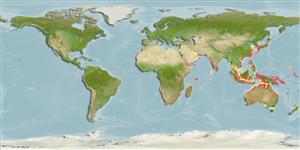Issue
Synonym of Moolgarda tade (Fabricius 1775) (Ref. 132106).
Environment: milieu / climate zone / depth range / distribution range
Écologie
marin benthopélagique. Subtropical
Indo-West Pacific: East Africa south to Knysna, South Africa and east to the western Pacific.
Taille / Poids / Âge
Maturity: Lm ? range ? - ? cm
Max length : 60.0 cm TL mâle / non sexé; (Ref. 11441)
Épines dorsales (Total) : 4; Rayons mous dorsaux (Total) : 9; Épines anales: 3; Rayons mous anaux: 9. Caudal fin deeply emarginate; silvery blue-grey on back, silvery on sides and ventrally; pectoral fins yellowish with a black spot at upper base (Ref. 11441).
Oviparous, eggs are pelagic and non-adhesive (Ref. 205).
Life cycle and mating behavior
Maturité | Reproduction | Frai | Œufs | Fécondité | Larves
Randall, J.E., 1995. Coastal fishes of Oman. University of Hawaii Press, Honolulu, Hawaii. 439 p. (Ref. 11441)
Statut dans la liste rouge de l'IUCN (Ref. 130435: Version 2024-2)
Menace pour l'homme
Harmless
Utilisations par l'homme
Outils
Articles particuliers
Télécharger en XML
Sources Internet
Estimates based on models
Preferred temperature (Ref.
123201): 23.2 - 29, mean 27.5 °C (based on 410 cells).
Phylogenetic diversity index (Ref.
82804): PD
50 = 1.0000 [Uniqueness, from 0.5 = low to 2.0 = high].
Bayesian length-weight: a=0.01175 (0.00555 - 0.02485), b=2.96 (2.79 - 3.13), in cm total length, based on LWR estimates for this (Sub)family-body shape (Ref.
93245).
Niveau trophique (Ref.
69278): 2.3 ±0.1 se; based on size and trophs of closest relatives
Résilience (Ref.
120179): Milieu, temps minimum de doublement de population : 1,4 à 4,4 années (Preliminary K or Fecundity.).
Fishing Vulnerability (Ref.
59153): Moderate vulnerability (44 of 100).
